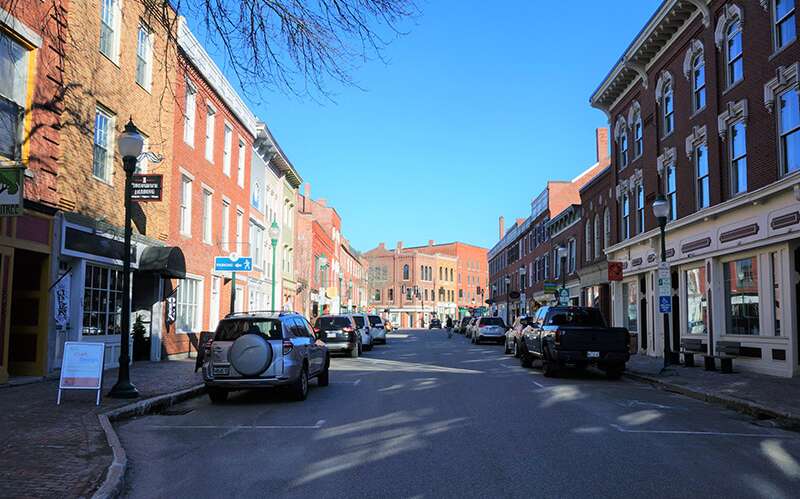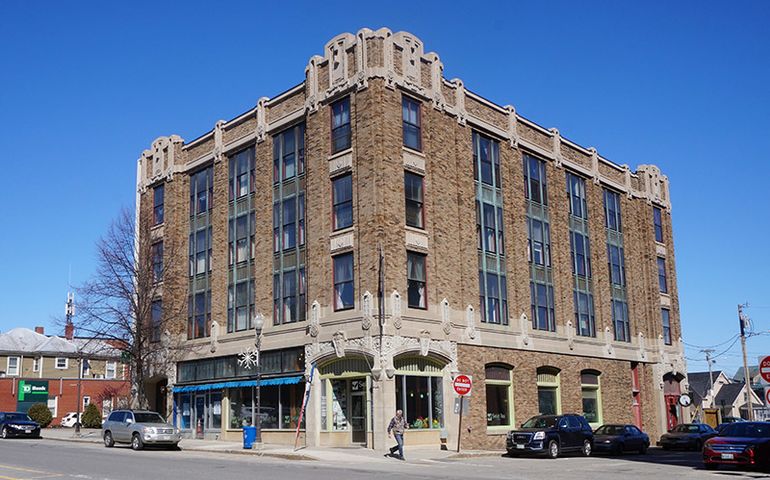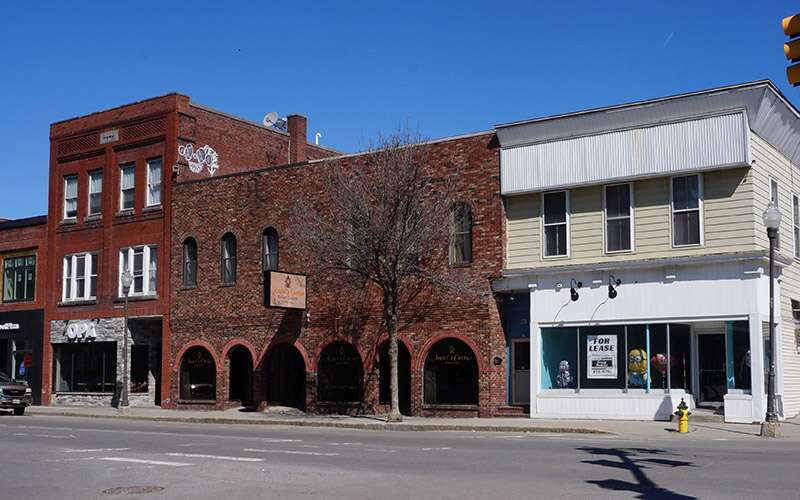
Waterville, Fairfield facade programs seen as development tool
 Photo / Maureen Milliken
177-179 Main St. in Waterville will benefit from a facade grant. The 1922 Art Deco building, the Cyr Block, as is the case with all 11 buildings getting facade grants, is on the National Register of Historic Places.
Photo / Maureen Milliken
177-179 Main St. in Waterville will benefit from a facade grant. The 1922 Art Deco building, the Cyr Block, as is the case with all 11 buildings getting facade grants, is on the National Register of Historic Places.
Grants for facade improvements to 11 downtown Waterville buildings are expected to have a much larger impact on the district than the individual projects themselves — something facade improvement programs across the state are finding.
The Waterville program means $325,000 direct investment into downtown, according to the Central Maine Growth Council.
The council’s Facade and Building Improvement Grant Program last week announced winners of $60,000 worth of grants from between $2,000 to $10,000. The program encourages downtown property owners to invest in commercial storefronts, restore the historical elements of their buildings and be a catalyst for similar work on neighboring buildings.
The program joins others across the state, including a new one in neighboring Fairfield, that look to spruce up buildings, in both big and small ways, to help sustain downtown economic investment and development.
The winning Waterville businesses were chosen from 23 applicants.
“The strength and quality of the applications we received was spectacular,” said Garvan Donegan, director of planning and economic development at the growth council. “Downtown businesses and property owners are extremely thoughtful in how their storefronts add to the character of downtown and contribute to a successful local economy, and their applications honor the architectural design roots and cultural significance of their buildings.”
'First impressions are everything'

Such programs make a difference, said Piper Panzeri, executive director of Gardiner Main Street.
In Gardiner, the facade committee awarded grants totaling $140,000 to 14 businesses in 2017. Work was completed last spring.
"First impressions are everything,” Panzeri told Mainebiz Wednesday. “You want to engage potential customers by triggering one of the five senses as they turn down your main street; for us, Water Street."
She said the work makes a difference.
"Historically renovated facades made an immediate impression; they engage the desire to stop and explore," she said.
She said they also have a long-term economic effect.
“The aesthetic and economic benefits of the facade program work together to drive historic preservation and the incremental economic and community development Main Street Maine communities are known for."
There have been similar programs across the state, including one in Bangor with a deadline of April 26.The spring program follows a similar one last fall.
Bangor’s program offers matching grants up to $15,000 and, like Gardiner’s, is funded through the Community Development Block Grant program.
Donegan said the growth council, which supports the Waterville area, is “highly supportive” of facade programs.
“[They’re] a mechanism to incentivize direct downtown investment and stimulate business expansion, retention and creation,” he said.
Fairfield project

Fairfield, just north of Waterville on U.S. Route 201, launched a Facade Improvement and Marketing Program earlier this month.
Fairfield's Façade Improvement and Marketing Assistance Program will award matching grants that can pay for renovation, restoration and preservation of privately owned business exteriors in town, as well as marketing to help commerce.
“Place-based economics are a driving force behind vibrant municipalities in the 21st century,” Donegan said when the growth council announced the program. “A high quality of place attracts investment, residents, and visitors, making [the Fairfield program] an important opportunity to realize the full potential of Fairfield’s commercial properties, including historical facilities in the downtown district.”
The Fairfield grants are for between $3,000 and $25,000 and the money comes from tax increment financing.
Proposals that win grants will generate significant economic and community development impact, according to the growth council’s news release on the program. Fairfield has a lot of land, but a small downtown of a few blocks. Main Street is U.S. Route 201.
Town Manager Michelle Flewelling said, “The advisory committee will prioritize projects which strongly contribute to the revitalization of our downtown district, to the restoration of our historic resources and to job creation.”
Fairfield’s is municipally managed by Flewelling and the Fairfield Economic and Community Development Advisory Committee, which CMGC assists with staffing. The program also has a broad marketing aspect, and it doesn’t just include downtown. “However, there is priority focus for the downtown district,” Donegan said.
Grants funded by Colby, Alfond Foundation

The Waterville program is an outgrowth of the more than $100 million in investment in downtown Waterville over the past few years, spurred by Colby College revitalization efforts.
It’s an in-house project by the Central Maine Growth Council, and the grants are funded by Colby College and the Bill and Joan Alfond Foundation and reimburse up to 50% of the total estimated project budget.
The money may be used for everything from awnings and signs to brick repointing to the removal of “inappropriate, non-historical” alterations to building exteriors.
Grants went to property that houses a variety of locally owned retail businesses and restaurants:
- 46 Main St., Framemakers
- 48 Main St., Enchanted Herbs & Tea
- 52 Main St., Children’s Book Cellar
- 54 Main St., SBS Carbon Copy
- 72 Main St., Holy Cannoli
- 80-88 Main St., Day’s Jewelers
- 129 Main St., Tap LLC
- 137 Main St., Amici’s Cucina
- 139 Main St., Opa
- 177-179 Main St., Black Cape Comics and Selah Tea Cafe.
History comes to life

Most of the buildings are two and three-story brick buildings dating to the 1800s and early 1900s and the possibilities to bring them back to their original glory are great.
They all play a part in Waterville’s evolution over the past two centuries.
All of the buildings chosen are in the Downtown Historic District, which stretches four blocks up Main Street, from Spring Street north to Appleton Street.
The initial part, Spring to Temple, was added to the National Register of Historic Places in 2012, and the block from Temple to Appleton, which includes 177-179 Main St., was added in 2016.
The buildings in the historic district are “of significant importance to the economic and commercial history of the Waterville downtown,” said the report to the NRHP, written by Sutherland Conservation and Consulting, of Augusta, when the district was extended in 2016.
The 177-179 Main St. building, the Cyr Block, is an Art Deco building, constructed in 1922 and designed by the Portland architectural firm of William Miller and Raymond Mayo.
It’s across Temple Street from 173 Main St., which was renovated by Colby College, and kitty-corner from Colby’s new Alfond Commons dorm and mixed use building at 150 Main St.
Its ornate four-story facade also is in contrast to the more plain brick ones that line Main Street.
The National Register of historic places document says the facade, which hasn’t been covered over like many on Main Street, is in good shape.
“The only notable alterations to the exterior of the building are the aluminum framed storefront windows and doors on the primary facade and first bay on Appleton Street,” the document says. “In 2015, a number of deteriorated cast stone elements on the first story were replaced with cast stone copies of the originals. While the color match is off, the replacement elements retain the character of the original features.”
It was built on the site of the Haines mansion, which was the home of William Haines before he became governor in 1913. The mansion was torn town in 1910 and the Cyr Block, one of the earliest prominent buildings to be built by a member of the Franco-American community, went up.

The building at 129 Main St. is the last surviving wood-frame building on Main Street, according to National Register documents. While it’s construction date isn’t known, it was renovated in 1877.
“Although a combination of modern siding materials have been added to the building, it appears that many elements of the original ltalianate trim remain underneath the aluminum siding,” the register document says.
It started out as a dry good store, and over two centuries has housed a florist, photography studios, a hair solon and more. It is currently vacant and looking for tenants to lease,
The building at 139 Main St. which now has Opa, a new Greek restaurant, on the first floor, was home to the first corporate offices of Central Maine Power Co., which was on the upper floors.
The national register documents offer this detail: “A fire that destroyed the neighboring steam laundry building and several other buildings to the north did $14,250 in fire and water damage to CMP's merchandise in the building.”
Donegan told Mainebiz in December, when the program was announced, “This program will help our local downtown businesses and retailers in a very tangible way and help propel new businesses to enter the district.
“The improvements funded through this program will make existing businesses increasingly inviting places to shop, work, and recreate, while revitalizing streetscapes and commercial corridors in the downtown."
Projects funding by the grants are expected to begin shortly.










0 Comments